|
The NNN Newsletter
Nanoinformatics 2011 Supports Updated NNI EHS Research Strategy

The responsible development of nanotechnology has an impact across essentially all economic sectors, including advanced manufacturing. As core research areas of the recently released 2011 National Nanotechnology Initiative (NNI) Environmental Health and Safety (EHS) Research Strategy include a nanomaterials measurement infrastructure, as well as informatics and modeling, it has become evident that efforts must be established to develop consistency in materials characterization between different laboratories, and develop a means to catalogue the data with as much meaningful, consistent information as possible. In this context, the National Nanomanufacturing Network (NNN) hosted Nanoinformatics 2010 in order to bring together the key stakeholders from academic centers, government laboratories, and regulatory agencies to begin to lay the groundwork for a concerted national roadmap in Nanoinformatics. Nanoinformatics 2010 was designed to survey the landscape, generate a roadmap, and stimulate collaborative activities in the area of nanoinformatics. The primary outcome of this workshop was the Nanoinformatics 2020 Roadmap (released April 2011), which was jointly authored by leaders in the nanoinformatics community of practice. Responding to the call for roadmaps in the National Nanotechnology Initiative Strategic Plan, it is the first broad-based community effort to articulate the comprehensive needs and goals in nanoinformatics. The development and widespread adoption of advanced nanoinformatics capabilities that accelerate responsible research, development, and deployment of nanotechnology—driven by the expertise and momentum of the R&D community and enabled by the agencies that support it—is the ultimate goal of the Nanoinformatics 2020 Roadmap. More....
Regards,
National Nanomanufacturing Network
Learn More about the 
Carbon Nanotube-Polymer Multilayer Structures for Light Weight, Enhanced Shock Absorbing Materials
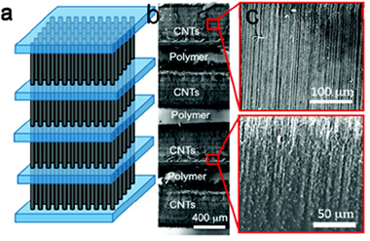 Carbon nanotubes (CNTs) have demonstrated unique mechanical properties similar to those found in various fibrous materials, exhibiting excellent compression capability combined with extreme structural flexibility and recovery from mechanical deformation. As such, arrays or forests of vertically aligned CNTs have been considered for ultra-light weight shock absorbing material. In addition, CNTs incorporate multifunctional properties, including excellent electrical and thermal conductivity. These properties then allow layers formed for energy absorption to monitor in situ strain loading. The utilization of vertically oriented CNT arrays for mechanical energy absorbing benefits from fundamental understanding of stress wave mitigation ad deformation mechanisms in fiber reinforced composites or porous foam-like materials where layered structures of materials have been adopted for shock and vibrational damping. As weight reduction is an important feature of incorporating such materials having advanced multifunctional properties for practical impact protection, multilayer CNT arrays represent a viable candidate for such applications. For practical implementation, as-grown CNTs by chemical vapor deposition (CVD) tend to exhibit a softer base, and thus are more prone to buckling and deformation, making them excellent candidates for energy absorbing materials. Previous approaches to multilayer arrays incorporating vertically aligned CNTs on metal foils or other inorganic layers have shown some improvements in energy absorption properties, yet remain limited as a result of the weak adhesion of the CNTs to the substrate. More.... Carbon nanotubes (CNTs) have demonstrated unique mechanical properties similar to those found in various fibrous materials, exhibiting excellent compression capability combined with extreme structural flexibility and recovery from mechanical deformation. As such, arrays or forests of vertically aligned CNTs have been considered for ultra-light weight shock absorbing material. In addition, CNTs incorporate multifunctional properties, including excellent electrical and thermal conductivity. These properties then allow layers formed for energy absorption to monitor in situ strain loading. The utilization of vertically oriented CNT arrays for mechanical energy absorbing benefits from fundamental understanding of stress wave mitigation ad deformation mechanisms in fiber reinforced composites or porous foam-like materials where layered structures of materials have been adopted for shock and vibrational damping. As weight reduction is an important feature of incorporating such materials having advanced multifunctional properties for practical impact protection, multilayer CNT arrays represent a viable candidate for such applications. For practical implementation, as-grown CNTs by chemical vapor deposition (CVD) tend to exhibit a softer base, and thus are more prone to buckling and deformation, making them excellent candidates for energy absorbing materials. Previous approaches to multilayer arrays incorporating vertically aligned CNTs on metal foils or other inorganic layers have shown some improvements in energy absorption properties, yet remain limited as a result of the weak adhesion of the CNTs to the substrate. More....
Responsible Development of Nanotechnology: Maximizing Results while Minimizing Risk
 Nanotechnology holds the promise of new materials and devices that can be designed and engineered to solve critical questions in almost every sector of our economy - from treating cancer, to cleaning contaminated water, accelerating advanced manufacturing, meeting energy needs, and fixing our roadways and bridges. That's why, for the last 10 years, the United States has engaged in an ambitious effort through the National Nanotechnology Initiative (NNI) to leverage the research programs and resources of Federal agencies and maximize the potential for translating the results of nanotechnology research into products that strengthen the economy and improve our quality of life. More... Nanotechnology holds the promise of new materials and devices that can be designed and engineered to solve critical questions in almost every sector of our economy - from treating cancer, to cleaning contaminated water, accelerating advanced manufacturing, meeting energy needs, and fixing our roadways and bridges. That's why, for the last 10 years, the United States has engaged in an ambitious effort through the National Nanotechnology Initiative (NNI) to leverage the research programs and resources of Federal agencies and maximize the potential for translating the results of nanotechnology research into products that strengthen the economy and improve our quality of life. More...
Manufacturing Goes Viral
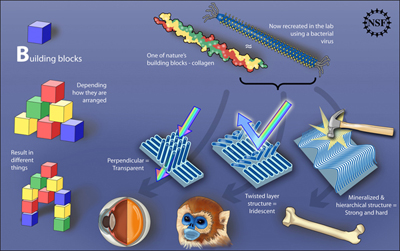 Using a simple, single-step process, engineers and scientists at the University of California at Berkeley recently developed a technique to direct benign, filamentous viruses called M13 phages to serve as structural building blocks for materials with a wide range of properties. Using a simple, single-step process, engineers and scientists at the University of California at Berkeley recently developed a technique to direct benign, filamentous viruses called M13 phages to serve as structural building blocks for materials with a wide range of properties.
By controlling the physical environment alone, the researchers caused the viruses to self-assemble into hierarchically organized thin-film structures, with complexity that ranged from simple ridges, to wavy, chiral strands, to truly sophisticated patterns of overlapping strings of material--results that may also shed light on the self-assembly of biological tissues in nature.
Each film presented specific properties for bending light, and several films were capable of guiding the growth of cells into structures with precise physical orientations.
Led by University of California at Berkeley bioengineer Seung-Wuk Lee and his student and lead author Woo-Jae Chung, the researchers published their findings in the Oct. 20, 2011, issue of Nature.
More....
Read more on  |



Advertisements
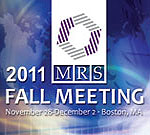
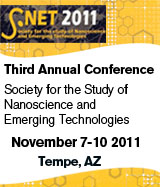
Job Opportunities
NANOELECTROMECHANICAL MOTION IN FUNCTIONAL MATERIALS - 13 positions to announce
Postdoctoral and PhD Positions in Applied Physics and Chemistry of Nanomaterials
Upcoming Events
Nov 21-25, 2011
Trends in Nanotechnology International Conference TNT2011
Nov 28 - Dec 2
MRS Fall Meeting 2011
Dec 5-7, 2011
2011 NSF Nanoscale Science and Engineering Grantees Conference
December 7-9, 2011
Nanoinformatics 2011
View Full Calendar
Upcoming Calls
MRS Spring Meeting 2012
Submissions accepted until: November 1, 2011
SPIE Photonics Europe 2012
Submissions accepted until November 7, 2011
International Conference on Nano Science and Technology
Submissions accepted until December 15, 2011
International Conference on the Chemistry of Nanotubes and Graphene
Submissions accepted until December 15, 2011
View All Calls
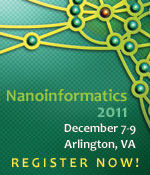
Recently Published
From Our Affiliates
Solid-state superionic stamping with silver iodide-silver metaphosphate glass
Nanotechnology 22(42)
Hierarchical Superhydrophobic Surfaces Fabricated by Dual-Scale Electron-Beam-Lithography with Well-Ordered Secondary Nanostructures
Advanced Functional Materials 21(19):3715-3722
Functionally Decoupled Soft Lithography for Patterning Polymer Brushes
Small 7(18):2669-2674
Synthesis, assembly and applications of semiconductor nanomembranes
Nature 477(7362):45-53
Basis Task Approach to Iterative Learning Control With Applications to Micro-Robotic Deposition
IEEE Transactions on Control Systems Technology 19(5):1138-1148
Affiliated Centers






|
 Volume
4 Issue 10 - October 2011
Volume
4 Issue 10 - October 2011
 Carbon nanotubes (CNTs) have demonstrated unique mechanical properties similar to those found in various fibrous materials, exhibiting excellent compression capability combined with extreme structural flexibility and recovery from mechanical deformation. As such, arrays or forests of vertically aligned CNTs have been considered for ultra-light weight shock absorbing material. In addition, CNTs incorporate multifunctional properties, including excellent electrical and thermal conductivity. These properties then allow layers formed for energy absorption to monitor in situ strain loading. The utilization of vertically oriented CNT arrays for mechanical energy absorbing benefits from fundamental understanding of stress wave mitigation ad deformation mechanisms in fiber reinforced composites or porous foam-like materials where layered structures of materials have been adopted for shock and vibrational damping. As weight reduction is an important feature of incorporating such materials having advanced multifunctional properties for practical impact protection, multilayer CNT arrays represent a viable candidate for such applications. For practical implementation, as-grown CNTs by chemical vapor deposition (CVD) tend to exhibit a softer base, and thus are more prone to buckling and deformation, making them excellent candidates for energy absorbing materials. Previous approaches to multilayer arrays incorporating vertically aligned CNTs on metal foils or other inorganic layers have shown some improvements in energy absorption properties, yet remain limited as a result of the weak adhesion of the CNTs to the substrate.
Carbon nanotubes (CNTs) have demonstrated unique mechanical properties similar to those found in various fibrous materials, exhibiting excellent compression capability combined with extreme structural flexibility and recovery from mechanical deformation. As such, arrays or forests of vertically aligned CNTs have been considered for ultra-light weight shock absorbing material. In addition, CNTs incorporate multifunctional properties, including excellent electrical and thermal conductivity. These properties then allow layers formed for energy absorption to monitor in situ strain loading. The utilization of vertically oriented CNT arrays for mechanical energy absorbing benefits from fundamental understanding of stress wave mitigation ad deformation mechanisms in fiber reinforced composites or porous foam-like materials where layered structures of materials have been adopted for shock and vibrational damping. As weight reduction is an important feature of incorporating such materials having advanced multifunctional properties for practical impact protection, multilayer CNT arrays represent a viable candidate for such applications. For practical implementation, as-grown CNTs by chemical vapor deposition (CVD) tend to exhibit a softer base, and thus are more prone to buckling and deformation, making them excellent candidates for energy absorbing materials. Previous approaches to multilayer arrays incorporating vertically aligned CNTs on metal foils or other inorganic layers have shown some improvements in energy absorption properties, yet remain limited as a result of the weak adhesion of the CNTs to the substrate.  Nanotechnology holds the promise of new materials and devices that can be designed and engineered to solve critical questions in almost every sector of our economy - from treating cancer, to cleaning contaminated water, accelerating
Nanotechnology holds the promise of new materials and devices that can be designed and engineered to solve critical questions in almost every sector of our economy - from treating cancer, to cleaning contaminated water, accelerating  Using a simple, single-step process, engineers and scientists at the University of California at Berkeley recently developed a technique to direct benign, filamentous viruses called M13 phages to serve as structural building blocks for materials with a wide range of properties.
Using a simple, single-step process, engineers and scientists at the University of California at Berkeley recently developed a technique to direct benign, filamentous viruses called M13 phages to serve as structural building blocks for materials with a wide range of properties.







